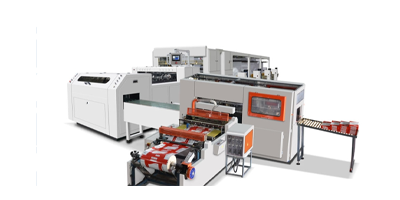In the modern paper processing industry, the A4 paper sheeting and packing machine plays an extremely important role. Its efficient and precise working process ensures that A4 papers can be produced and packed in high quality to meet the needs of numerous fields.
I. Paper Input Stage
Firstly, rolls of paper are placed on the unwinding device of the machine. These paper rolls usually have relatively large widths and lengths to meet the demand for large-scale production of A4 papers. The unwinding device is equipped with a stable tension control system, which ensures that the paper maintains an appropriate tension during the conveying process and avoids slackening or excessive pulling. The precise control in this stage lays the foundation for the subsequent cutting and packing processes.
II. Cutting Process
After the paper is output from the unwinding device, it enters the cutting area. The cutting system is one of the core parts of the A4 paper sheeting and packing machine. The machine is equipped with high-precision cutting tools, such as rotary circular knives or reciprocating cutting knives. During the cutting process, according to the preset A4 paper size (210mm × 297mm), the cutting tools, driven by the power system, cut the paper horizontally and vertically with extremely high precision. Advanced cutting techniques can ensure that the cutting edges are neat and smooth, without burrs or tearing, so that the dimensional accuracy of the A4 paper reaches a very high standard, meeting the strict requirements of the office, printing and other industries for the consistency of paper size.
III. Counting and Sorting
The cut A4 papers need to be counted and sorted. The machine is equipped with an intelligent counting device that can accurately count the number of papers. While counting, through a series of mechanical transmission devices and sorting mechanisms, the cut A4 papers are arranged and sorted in a certain quantity and order. For example, usually 500 sheets of A4 papers are sorted into a stack for the subsequent packing process. This process needs to ensure the neatness and stability of the papers and prevent the papers from being misaligned or in disorder.
IV. Packing Stage
The sorted stacks of A4 papers enter the packing area. The packing system operates according to the preset packing method. Common packing materials include plastic films or paper wrapping papers. For plastic film packaging, the machine will stretch the film and wrap it around the stack of papers, and then use the heat sealing device to seal the film to form a sealed package. For paper packaging, the pre-cut wrapping paper is folded and pasted around the stack of papers to complete the packaging process. The packaged A4 paper products are not only aesthetically pleasing but also can effectively protect the papers from being damaged during transportation and storage.
V. Output and Finished Product Inspection
Finally, the packaged A4 paper finished products are conveyed out through the output device. During the output process, a finished product inspection stage is usually set up. Through photoelectric sensors or visual inspection systems, the appearance of the packaged products is inspected, such as checking whether the packaging is complete, whether there are any damages, and whether the labels are pasted correctly. Only the products that have passed the inspection will be officially collected and stored, ready to enter the market for sale or be supplied to downstream enterprises for use.
In conclusion, the A4 paper sheeting and packing machine realizes the transformation from paper rolls to beautifully packaged finished products through a rigorous and efficient working process, prIn conclusion, the A4 paper sheeting and packing machine realizes the transformation from paper rolls to beautifully packaged finished products through a rigorous and efficient working process, providing strong technical support for the development of the paper processing industry.


GET A QUOTE